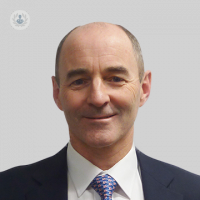Cholesteatoma: is it dangerous?
Escrito por:There are many things that can affect our ears and our hearing, but some are potentially more damaging than others. Cholesteatoma is a type of cyst, which, while not cancerous, has the potential to cause serious health problems. Leading ENT surgeon Mr Michael Pringle is here to explain.

What is a cholesteatoma?
A cholesteatoma is an expanding collection of dead skin in the space behind the eardrum, often spreading into the hollow bone behind the ear (the mastoid bone). It occurs when the eardrum collapses inwards and takes its surface layer of skin with it. Rather than shedding into the ear canal, the skin starts to build up and forms a cyst full of dead skin. As this cyst slowly gets bigger, it can damage the delicate and important structures behind the eardrum. A cholesteatoma has nothing to do with cancer.
What are the symptoms of a cholesteatoma?
If the collection of dead skin becomes infected, this can cause discharge from the ear, which is often smelly. The other common symptom of a cholesteatoma is deafness. Sometimes, a cholesteatoma can have no symptoms until it presents with one of the serious complications discussed below.
Is a cholesteatoma painful?
No, a cholesteatoma is not usually painful.
Is a cholesteatoma dangerous to the health?
Yes, a cholesteatoma is dangerous to the health. If left untreated, it can grow and damage some or all of the important structures behind the ear, which, in turn, can lead to debilitating complications. Examples include:
- The facial nerve – this can lead to facial palsy.
- The bones involved in hearing – this can cause deafness and possibly tinnitus.
- The balance system – this can result in dizziness or total loss of balance and hearing function in that ear, known as a dead ear.
- The bony covering separating the ear from the brain can become worn away.
If the cholesteatoma is infected, the infection can spread into the mastoid bone, causing mastoiditis, or into the brain, causing a brain abscess or meningitis. Infection in the mastoid bone can also cause blockage of the big blood vessel draining blood from the brain.
Surgical removal of a cholesteatoma is nearly always recommended.
Can a cholesteatoma cause hearing loss?
Yes – this is often how it presents. It can cause ‘conductive’ hearing loss by wearing away the ear bones. This type of hearing loss can often be corrected by surgery. It can also cause a ‘nerve’ or ‘sensorineural’ hearing loss which cannot be corrected by surgery.
When should you see a doctor?
You should see a doctor so they can look at your ear drum if you have deafness, dizziness, or a runny ear. If the runny ear is smelly, this is very suspicious of cholesteatoma, although not all cholesteatomas smell.
For more information or to book an appointment, visit Mr Pringle’s Top Doctors profile.


